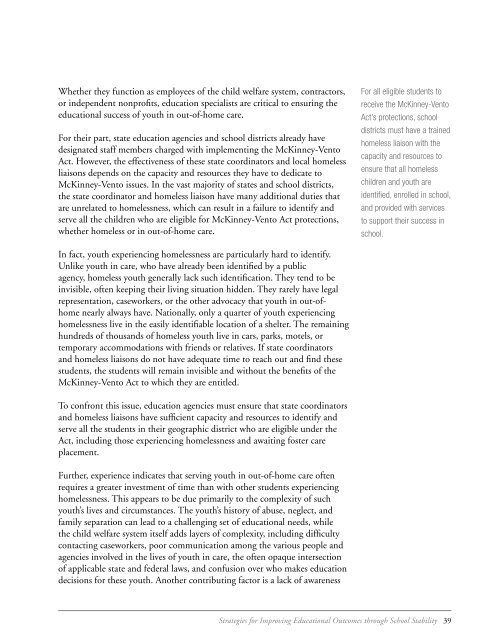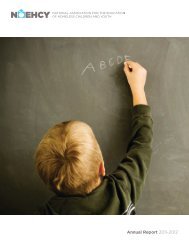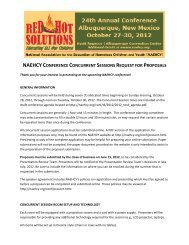The McKinney-Vento Act and Children and Youth ... - State of Michigan
The McKinney-Vento Act and Children and Youth ... - State of Michigan
The McKinney-Vento Act and Children and Youth ... - State of Michigan
You also want an ePaper? Increase the reach of your titles
YUMPU automatically turns print PDFs into web optimized ePapers that Google loves.
Whether they function as employees <strong>of</strong> the child welfare system, contractors,<br />
or independent nonpr<strong>of</strong>its, education specialists are critical to ensuring the<br />
educational success <strong>of</strong> youth in out-<strong>of</strong>-home care.<br />
For their part, state education agencies <strong>and</strong> school districts already have<br />
designated staff members charged with implementing the <strong>McKinney</strong>-<strong>Vento</strong><br />
<strong>Act</strong>. However, the effectiveness <strong>of</strong> these state coordinators <strong>and</strong> local homeless<br />
liaisons depends on the capacity <strong>and</strong> resources they have to dedicate to<br />
<strong>McKinney</strong>-<strong>Vento</strong> issues. In the vast majority <strong>of</strong> states <strong>and</strong> school districts,<br />
the state coordinator <strong>and</strong> homeless liaison have many additional duties that<br />
are unrelated to homelessness, which can result in a failure to identify <strong>and</strong><br />
serve all the children who are eligible for <strong>McKinney</strong>-<strong>Vento</strong> <strong>Act</strong> protections,<br />
whether homeless or in out-<strong>of</strong>-home care.<br />
For all eligible students to<br />
receive the <strong>McKinney</strong>-<strong>Vento</strong><br />
<strong>Act</strong>’s protections, school<br />
districts must have a trained<br />
homeless liaison with the<br />
capacity <strong>and</strong> resources to<br />
ensure that all homeless<br />
children <strong>and</strong> youth are<br />
identified, enrolled in school,<br />
<strong>and</strong> provided with services<br />
to support their success in<br />
school.<br />
In fact, youth experiencing homelessness are particularly hard to identify.<br />
Unlike youth in care, who have already been identified by a public<br />
agency, homeless youth generally lack such identification. <strong>The</strong>y tend to be<br />
invisible, <strong>of</strong>ten keeping their living situation hidden. <strong>The</strong>y rarely have legal<br />
representation, caseworkers, or the other advocacy that youth in out-<strong>of</strong>home<br />
nearly always have. Nationally, only a quarter <strong>of</strong> youth experiencing<br />
homelessness live in the easily identifiable location <strong>of</strong> a shelter. <strong>The</strong> remaining<br />
hundreds <strong>of</strong> thous<strong>and</strong>s <strong>of</strong> homeless youth live in cars, parks, motels, or<br />
temporary accommodations with friends or relatives. If state coordinators<br />
<strong>and</strong> homeless liaisons do not have adequate time to reach out <strong>and</strong> find these<br />
students, the students will remain invisible <strong>and</strong> without the benefits <strong>of</strong> the<br />
<strong>McKinney</strong>-<strong>Vento</strong> <strong>Act</strong> to which they are entitled.<br />
To confront this issue, education agencies must ensure that state coordinators<br />
<strong>and</strong> homeless liaisons have sufficient capacity <strong>and</strong> resources to identify <strong>and</strong><br />
serve all the students in their geographic district who are eligible under the<br />
<strong>Act</strong>, including those experiencing homelessness <strong>and</strong> awaiting foster care<br />
placement.<br />
Further, experience indicates that serving youth in out-<strong>of</strong>-home care <strong>of</strong>ten<br />
requires a greater investment <strong>of</strong> time than with other students experiencing<br />
homelessness. This appears to be due primarily to the complexity <strong>of</strong> such<br />
youth’s lives <strong>and</strong> circumstances. <strong>The</strong> youth’s history <strong>of</strong> abuse, neglect, <strong>and</strong><br />
family separation can lead to a challenging set <strong>of</strong> educational needs, while<br />
the child welfare system itself adds layers <strong>of</strong> complexity, including difficulty<br />
contacting caseworkers, poor communication among the various people <strong>and</strong><br />
agencies involved in the lives <strong>of</strong> youth in care, the <strong>of</strong>ten opaque intersection<br />
<strong>of</strong> applicable state <strong>and</strong> federal laws, <strong>and</strong> confusion over who makes education<br />
decisions for these youth. Another contributing factor is a lack <strong>of</strong> awareness<br />
Strategies for Improving Educational Outcomes through School Stability 39














